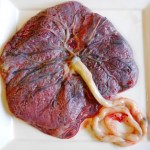placenta
Image of a tammar wallaby and her joey By Mathae - Own work via Wikimedia Commons
When I think of marsupials, what comes to mind is an image of a mother carrying her young (joey) in a pouch. Contrary to popular belief, however, mother tammar wallabies (Macropus eugenii) have an internal functioning placenta. Albeit, it only develops near the end of their short pregnancy (a mere 26.5 days), just before the developing offspring moves from the uterus to the pouch for further development and nursing. A new study published in eLife examined gene expression in both the placenta…
Well, not my placenta exactly, but ... well, someone's?
Did you now that the placenta that is born out of a female primate's body is an organ of the infant also being born? It is the first body part you lose. I use the term "primate" here because, even though all the "placental mammals" as we are called share some basic reproductive gestational anatomy, there are major categories across the mammals in this area, and primates are distinct from, for example, carnivores. These differences are of course very important when one is considering placentophagy. I mean, you wouldn't confuse a…
After nearly 11 years (!) at this blogging thing, I thought I had covered pretty much every medical topic a skeptic and supporter of science-based medicine would be interested in covering. However, if there's one thing I've learned over the years, it's that there's always something I've missed, some hole in my blogging oeuvre that needs to be filled. Perhaps when I've been at this for 20 years I'll have filled them all in. Even if that becomes true sometime in the next nine years, I will likely have only filled in the old gaps, while new ones will have formed. Dealing with pseudoscience is…
Evolutionary Novelties ponders placentas:
For me one of the most visceral confirmations of the common descent of humans and other mammals came while witnessing the birth of my children. Having grown up on a small farm, I have vivid memories of the birth of kittens, lambs, and goats; and after the births of my children, I was struck by the similarity of human placenta and umbilical cord to those of other mammals. Given common descent, how did something as complex as the mammalian placenta originate in the first place? The answer, according to research published last summer in Genome Research…

